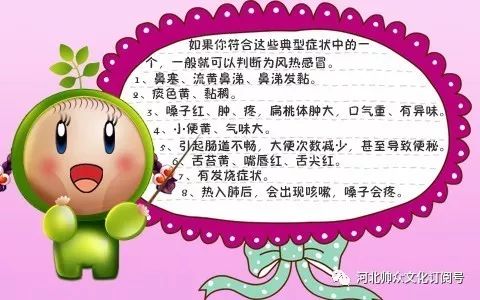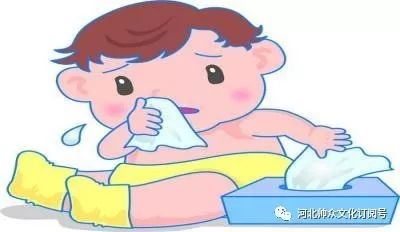
Wind-heat cold is caused by the invasion of wind-heat evil attacking the exterior and the disharmony of lung qi. Symptoms include high fever, slight aversion to wind, headache, sweating, sore and swollen throat, cough with sticky or yellow phlegm, nasal congestion with yellow discharge, thirst with a preference for drinking, a red tip and edges of the tongue, and a thin white or slightly yellow coating. Wind-heat cold is commonly seen in summer and autumn, resulting from the external invasion of wind-heat. Traditional Chinese Medicine (TCM) considers wind-heat cold as an exterior syndrome caused by the invasion of wind-heat evil.
Today, I will continue to share methods to treat various diseases without spending money:

According to the “Treatise on the Origins and Symptoms of Various Diseases – Wind-Heat Syndrome”: “In cases of wind-heat disease, the wind-heat qi first enters the lungs through the skin and hair. The lungs are the upper cover of the five organs, and the skin and hair are the indicators of the body. If the skin pores are weak, the wind-heat qi first harms the skin and hair before entering the lungs. This condition causes aversion to wind and cold, and the eyes may feel like they are going to pop out, with nasal discharge and saliva present.” The treatment should focus on dispersing wind-heat with acrid and cool herbs. Formulas such as Yin Qiao San (Yin Qiao Powder), Sang Ju Yin (Mulberry Leaf and Chrysanthemum Drink), Jie Geng Tang (Platycodon Decoction), Shang Qing San (Upper Clarity Powder), and Ju Hua San (Chrysanthemum Powder) are recommended. If the condition persists, the patient is likely deficient and should not solely rely on dispersing methods. For yang deficiency, add Ren Shen (Ginseng) and Bai Zhu (White Atractylodes); for yin deficiency, add Di Huang (Rehmannia) and Wu Wei Zi (Schisandra), and increase Mai Dong (Ophiopogon) and Bai Shao (White Peony).

Clinical symptoms include:
1. General symptoms
(1) Sore throat, usually occurring before other cold symptoms, with phlegm that is typically yellow or black.
(2) Thick nasal discharge, usually yellow.
(3) The tongue coating may be slightly yellow or possibly white, with the tongue body usually being quite red.
(4) Constipation.
(5) Fever, thirst, and irritability.
(6) The pulse is usually rapid or flooding, indicating a faster than normal heartbeat.
2. Symptoms of Wind-Heat Cold in Children
Children primarily present with high fever, but aversion to cold and wind is not obvious, nasal congestion with thick discharge, heavy cough, or thick yellow phlegm, headache, thirst, red and dry or itchy throat. Bowel movements are dry, urine is yellow, and examination may reveal red and swollen tonsils, congested throat, thin yellow or thick yellow tongue coating, red tongue body, and a floating and rapid pulse.

Wind-heat invasion commonly occurs in spring and summer. In spring, there is much wind, and the climate becomes warm, thus wind and warm-heat evils often combine to cause disease; in summer, the outdoor heat is oppressive while indoors is cooler, leading to unstable temperatures that can also cause illness. Wind-heat cold is the result of wind-heat evil invading the lung defense, causing disharmony of the defense and the lung’s ability to clear and regulate.
1. Main symptoms
(1) Fever, slight aversion to wind and cold, with sweating or little sweating, headache, and body aches;
(2) Nasal congestion, yellow thick discharge, cough, and red dry sore throat.
2. Secondary symptoms
Light sweating, dry mouth and thirst, cough with yellow thick phlegm.
3. Tongue and pulse signs
Red tip of the tongue, thin yellow coating; pulse is floating and rapid.
Diagnosis of wind-heat cold can be made if the main symptoms (1) and secondary symptoms are present, or main symptom (2) and secondary symptoms are present, along with typical tongue and pulse signs.

Recite twice daily for at least fifteen minutes each time, focusing on the painful areas. Results are quick!!!
Cold symptoms include body aches, cough, sore throat, with symptoms worsening at night and poor energy. This is caused by the invasion of wind-heat evil into the lungs.
Plan: Focus on dispersing wind and cold, and regulating lung qi.
Formula:
(1)20·60·50
(2)2000·50




